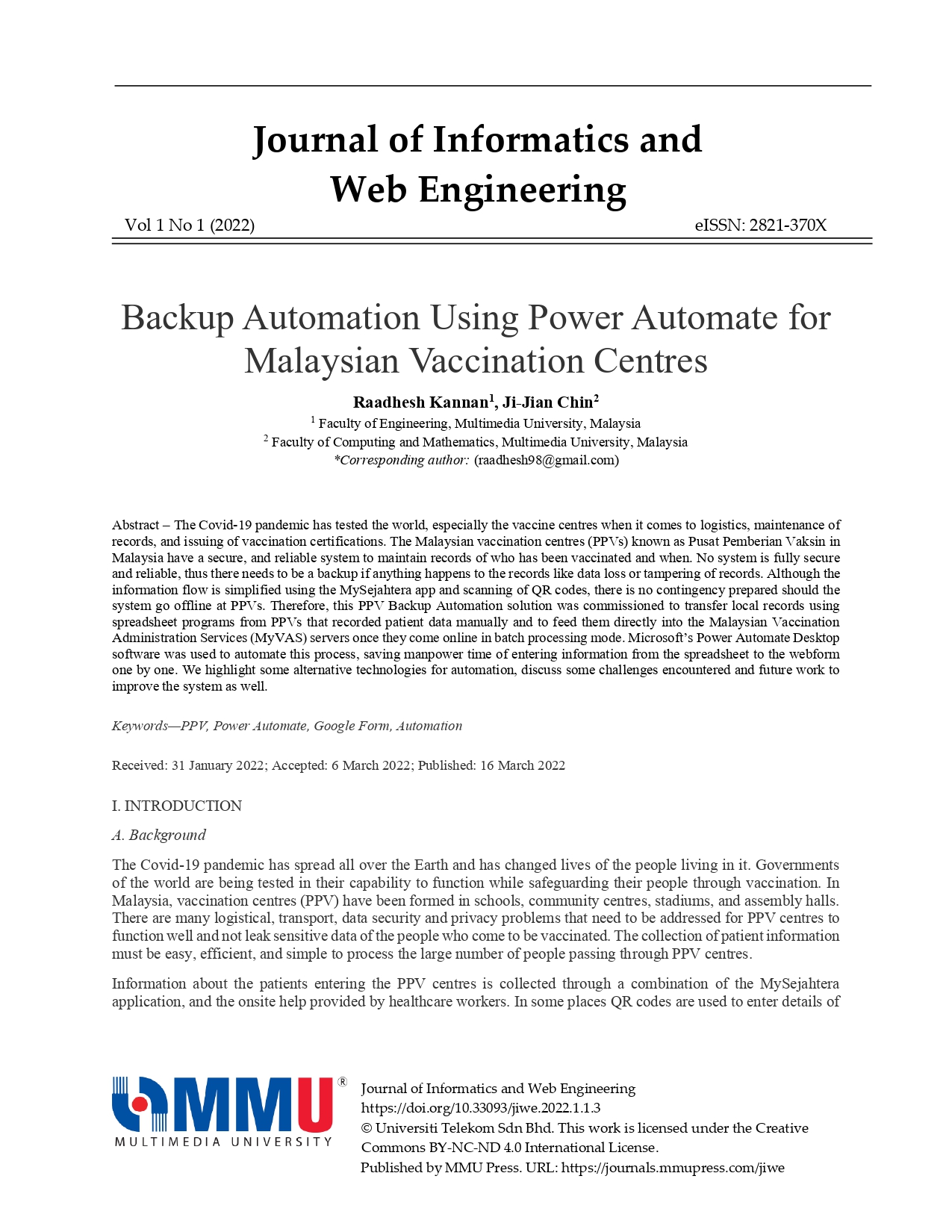Backup Automation Using Power Automate for Malaysian Vaccination Centres
Main Article Content
Abstract
The Covid-19 pandemic has tested the world, especially the vaccine centres when it comes to logistics, maintenance of records, and issuing of vaccination certifications. The Malaysian vaccination centres (PPVs) known as Pusat Pemberian Vaksin in Malaysia have a secure, and reliable system to maintain records of who has been vaccinated and when. No system is fully secure and reliable, thus there needs to be a backup if anything happens to the records like data loss or tampering of records. Although the information flow is simplified using the MySejahtera app and scanning of QR codes, there is no contingency prepared should the system go offline at PPVs. Therefore, this PPV Backup Automation solution was commissioned to transfer local records using spreadsheet programs from PPVs that recorded patient data manually and to feed them directly into the Malaysian Vaccination Administration Services (MyVAS) servers once they come online in batch processing mode. Microsoft’s Power Automate Desktop software was used to automate this process, saving manpower time of entering information from the spreadsheet to the webform one by one. We highlight some alternative technologies for automation, discuss some challenges encountered and future work to improve the system as well.
Article Details

This work is licensed under a Creative Commons Attribution-NonCommercial-NoDerivatives 4.0 International License.
All articles published in JIWE are licensed under a Creative Commons Attribution-NonCommercial-NoDerivatives 4.0 International (CC BY-NC-ND 4.0) License. Readers are allowed to
- Share — copy and redistribute the material in any medium or format under the following conditions:
- Attribution — You must give appropriate credit, provide a link to the license, and indicate if changes were made. You may do so in any reasonable manner, but not in any way that suggests the licensor endorses you or your use;
- NonCommercial — You may not use the material for commercial purposes;
- NoDerivatives — If you remix, transform, or build upon the material, you may not distribute the modified material.
References
B. Simanjuntak and T. Limbong, “Using Google form for student worksheet as learning media”, International Journal of Engineering and Technology, vol. 7, pp. 321–324, 2018.
W. M. P. van der Aalst, M. Bichler and A. Heinzl, “Robotic Process Automation”, Business and Information Systems Engineering, vol. 60, pp. 269-272, 2018, doi: 10.1007/s12599-018-0542-4.
N. G. Leveson, J. D. Reese and M. P. E. Heimdahl, “SpecTRM: a CAD system for digital automation”, DASC. AIAA/IEEE/SAE. Digital Avionics Systems Conference. Proceedings (Cat. No.98CH36267), vol. 1, pp. B52/1-B52/8, 1998, doi: 10.1109/DASC.1998.741474.
K. C. Moffitt, A. M. Rozario and M. A. Vasarhelyi, “Robotic process automation for auditing”, Journal of emerging technologies in accounting, vol. 15, pp. 1–10, 2018, doi: 10.2308/jeta-10589.
R. Issac, R. Muni and K. Desai, “Delineated Analysis of Robotic Process Automation Tools”, International Conference on Advances in Electronics, Computers and Communications (ICAECC), pp. 1-5, 2018, doi: 10.1109/ICAECC.2018.8479511.
C.-C. Osman, “Robotic Process Automation: Lessons Learned from Case Studies”, Informatica Economica, vol. 23, no. 4, pp. 66-71, 2019, doi: 10.12948/issn14531305/23.4.2019.06.
S. Agostinelli, A. Marrella and M. Mecella, “Towards Intelligent Robotic Process Automation for BPMers”, 2020, doi: 10.48550/arXiv.2001.00804.
C. Houy, M. Hamberg and P. Fettke, “Robotic Process Automation in Public Administrations”, Digitalisierung von Staat und Verwaltung, Bonn, pp. 62-74, 2019.
M. Romao, J. Costa and C. J. Costa, “Robotic Process Automation: A Case Study in the Banking Industry”, Iberian Conference on Information Systems and Technologies (CISTI), pp. 1-6, 2019, doi: 10.23919/CISTI.2019.8760733.
T. Kobayashi, K. Arai, T. Imai, S. Tanimoto, H. Sato and A. Kanai, “Communication Robot for Elderly Based on Robotic Process Automation”, IEEE Annual Computer Software and Applications Conference (COMPSAC), vol. 2, pp. 251-256, 2019, doi: 10.1109/COMPSAC.2019.10215.
S. Parchande, A. Shahane and M. Dhore, “Contractual Employee Management System Using Machine Learning and Robotic Process Automation”, International Conference On Computing, Communication, Control And Automation (ICCUBEA), pp. 1-5, 2019, doi: 10.1109/ICCUBEA47591.2019.9128818.
B. Axmann and H. Harmoko, “Robotic Process Automation: An Overview and Comparison to Other Technology in Industry 4.0”, International Conference on Advanced Computer Information Technologies (ACIT), pp. 559-562, 2020, doi: 10.1109/ACIT49673.2020.9208907.
M. Abdou, A. M. Ezz and I. Farag, “Digital Automation Platforms Comparative Study”, International Conference on Information and Computer Technologies (ICICT), pp. 279-286, 2021, doi: 10.1109/ICICT52872.2021.00052.
A. Kajrolkar, S. Pawar, P. Paralikar and N. Bhagat, “Customer Order Processing using Robotic Process Automation”, International Conference on Communication information and Computing Technology (ICCICT), pp. 1-4, 2021, doi: 10.1109/ICCICT50803.2021.9510109.

